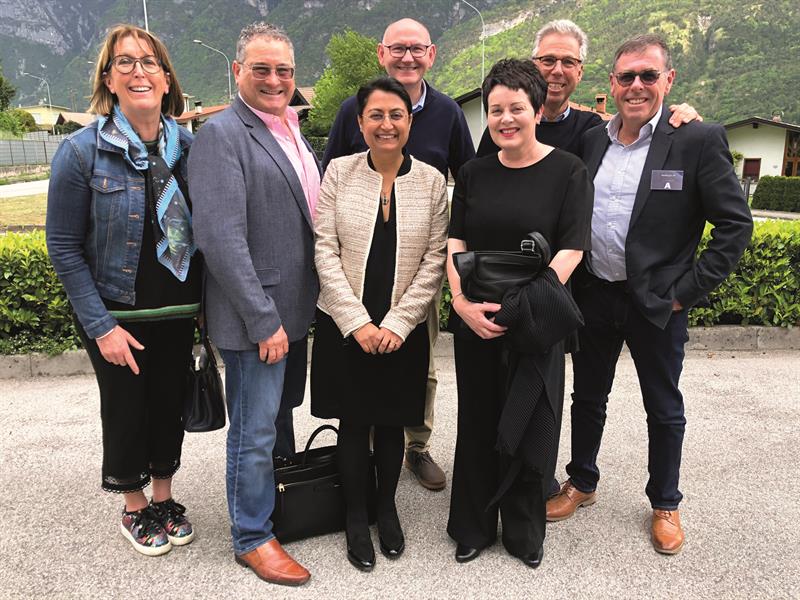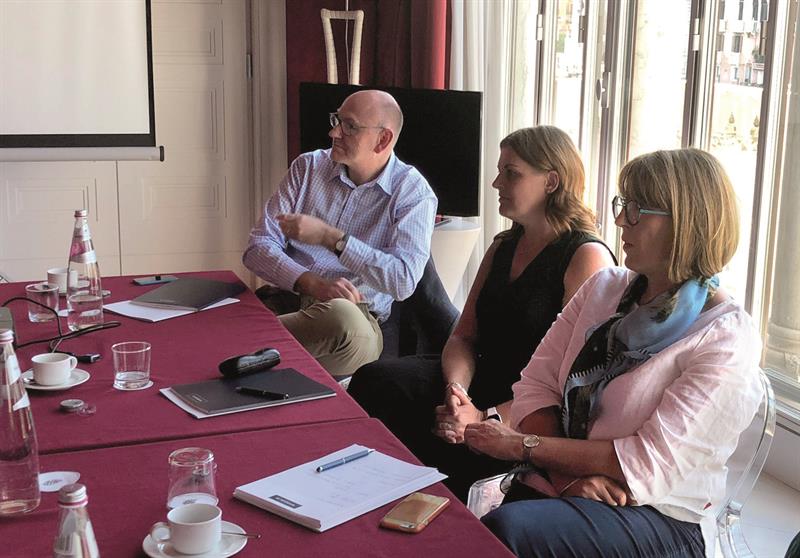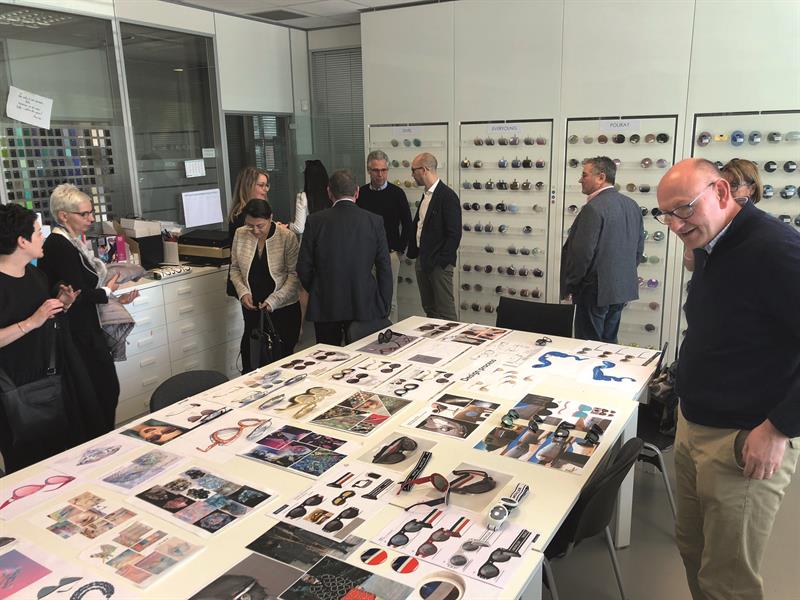 Eavan Kennedy, owner of EK Eyewear and Opticians; Marc Karbaron , owner of Optix of Broadgate; Priti Kotecha, director of Roger Pope Opticians; Scott Currie of Glasgow’s Currie & Quirk Opticians; Sheinman Opticians customer services manager Lynda Watts; David H Myers Opticians owner David Myers; and Silverberg Opticians managing director Ian Silverberg Group outside Marcolin’s Longarone factory
Eavan Kennedy, owner of EK Eyewear and Opticians; Marc Karbaron , owner of Optix of Broadgate; Priti Kotecha, director of Roger Pope Opticians; Scott Currie of Glasgow’s Currie & Quirk Opticians; Sheinman Opticians customer services manager Lynda Watts; David H Myers Opticians owner David Myers; and Silverberg Opticians managing director Ian Silverberg Group outside Marcolin’s Longarone factory
Independent practices have never had it so tough. What seems like decades spent under pressure from multiples is now compounded by additional forces from online retail, escalating costs and a new type of consumer-savvy patient who is not necessarily motivated by the health of their eyes.
Optician invited some prominent independent opticians to visit Venice for a roundtable discussion where the issues could all be laid bare. Optician was tasked with hosting the discussion and also provided the framework for the topics the panel would discuss. While keen to hear the outcomes of the conversations, Marcolin Group did not want to drive the content of the debate.
Overlooking the Grand Canal, the palatial Hotel Sina Centurion plays host to a group made up of: Eavan Kennedy, owner of EK Eyewear and Opticians in Belfast; Silverberg Opticians managing director Ian Silverberg; Bayfields Opticians group operations director Geraldine Meade, Scott Currie of Glasgow’s Currie & Quirk Opticians; David H Myers Opticians owner David Myers, Optix of Broadgate owner Marc Karbaron and Roger Pope Opticians director Priti Kotecha.
After lunch, time spent admiring the views and listening to the Venetian melodies of gondoliers, Optician opens the discussion with tough question: What’s the outlook for independent opticians in the UK? Silverberg was the first to have his say: ‘I would have to say that the future of independent opticians as we know them is very much in doubt. Many successful practice owners are now considering retirement but there are very few young opticians and optometrists coming through that have the desire and financial means to own a business.’
Silverberg explains to the group that his sons have not shown an interest in taking over the practice, so when it came to consideration over his future, he turned to the Hakim Group, which has now taken a share of his Liverpool business.
‘For me, I don’t think succession is the biggest change facing independent optics, it’s the standards of the people coming through,’ says Marc Karbaron. ‘We’re a group of successful practitioners here at this table. But, trust me, out there, there are such a lot of dire practitioners. I have had so many people interview for jobs or taken them on and found that even the ones I thought knew what they were talking about, did not know what they were talking about.’
Worryingly, it’s a sentiment that is shared around the table. ‘It’s quite refreshing because sometimes you think to yourself, “Is it me?” We have been talking about buying a practise and running a business, but there needs to be training for that. If they’re coming out of college and all they know is the dispensing theory, they’re going to be petrified the first time the bills start coming in, tax needs to be calculated and when HR issues begin to crop up,’ says Kotecha.
Optician asks her what the solution could be. ‘There needs to be changes made to the courses, for starters,’ she says. ‘I was always put off with the dispensing course because I felt that what I did on the shop floor didn’t reflect everything that I would have learned in college.
‘I’m not saying there isn’t a place for qualified, well-trained dispensing opticians – in our practice, we have five, but I think there’s no emphasis and no training on running an optical business in their education,’ she says.
According to Silverberg, the problem of fewer business-led practitioners isn’t just limited to dispensing opticians. ‘I interviewed an optometrist recently and he looked very promising. I offered him the job and after a few days, he replied and said, “are there any other optometrists in the practice?” I told him none and he turned the job down because he liked working with optometrists and couldn’t take the sole responsibility.’
Scott Currie thinks part of the reason why so many optometrists lack the skillset to run businesses is partly down to settings where they work. ‘The optometrists that are working for multiples are in the testing rooms all the time. They’re not exposed to what is required to run a business,’ he says.
David Myers is unequivocal in his response: ‘You’re absolutely right, Scott. They’re refraction machines.’
 Marcolin HQ
Marcolin HQ
Currie agrees: ‘Thirty or 40 years ago an optometrist was doing the eye test, fitting the frames and many other jobs. That just isn’t true of the modern optometrist – especially in England. In Scotland, there is a greater emphasis on medical treatment with sophisticated equipment. Optometrists are almost removing themselves from dispensing.’
Karbaron predicts a gloomy future for optometrists. ‘I’m a firm believer that optometry could well dissolve in the next 10 years,’ he says. ‘Now, optometrists will hate to hear this, but if you really think about it, it’s a very repetitive event. You’re doing the refraction and you’re looking for anomalies of the eye and vision. Artificial intelligence (AI) will do a perfectly good job of both of those soon.’
But Myers is more optimistic about the future of the independent optics. ‘I really don’t see all this as the death of our industry. I think that what we must do is differentiate ourselves from the high street multiples.’
An animated Myers asks the panel to list what makes its practices differentiated. ‘Service’, ‘quality’ and ‘after-sales care’ were the most popular responses around the table.
Brand awareness
One of the biggest challenges opticians have faced during the past decade has been the growth of online retail. Patient awareness of brands and the cost of product has changed the dynamic of the relationship between eyewear supplier and optical retailer – with some suppliers opting to become the retailer as well.
Eavan Kennedy outlines one of her gripes with brands and online visibility. ‘In the last year our practice took on a brand. We then had a girl from one of the nearby fashion shops ask us if we could get her the frame. She showed us the online photograph and you could buy it for £100 less than what we were told to retail the frame for. I had to phone the rep and ask, “how can I compete against that?”’
‘You’re exactly right,’ says Silverberg. ‘I can find clothing from a brand that is only discounted by small percentage in a sale, but the sunglasses are available for less than the wholesale cost we pay.’
So perhaps the answer lies in being less brand led? Not according to Kotecha and Myers. ‘You need to be market led, because if your customers are coming in and they’re asking you, “where’s X and where’s Y?” you need to show them something,’ says Kotecha. ‘Absolutely,’ says Myers, ‘You’re not going to sell them something else.’
Competing or differentiating has long been the dichotomy of business owners, but the truth is that there is no correct answer. As professional services manager for Bayfields Opticians, Meade says the company has tried to address areas where it has lost out. ‘We brought in some basic complete prices because we lost dispenses to multiples and online, and it has started to work for us.’
 Ian Silverberg, David Myers and Marc Karbaron
Ian Silverberg, David Myers and Marc Karbaron
Optician asks the group how they feel about adjusting frames that have been purchased online – a question that usually provides polarised opinions. ‘We don’t do it at Roger Pope,’ says Kotecha. ‘We do it, but we charge,’ says Silverberg. Myers says his practice charges £40 for a frame adjustment, adding, ‘people pay it, too, which I find incredible.’
Karbaron explains how he used to offer the service but reconsidered his position. ‘I just tell them to take it back. If they say, “Well, I got it online,” I tell them that they get what they paid for. We stopped because I felt that legally, the minute we adjusted something, we took the responsibility for the ongoing life of that product. If anything were to happen to it and the customer sent it back to xyz.co.uk, the supplier could say, “Well, these have been adjusted. They damaged it. Go back to them.” I don’t want that happening.’
He continues: ‘We’ve talked about differentiating yourself, but I think that differentiation will be perhaps down to the accuracy of prescriptions in future.
‘I had someone come in a few weeks ago – about a minus eight in each eye with progressive lenses. He couldn’t see out of his new glasses he bought online. We just said, “We’re not even going to touch them. Don’t even put them on the table. Just get your money back.” How could someone be so stupid? This was
someone in the city, relatively educated, but felt that they
could save themselves a few hundred pounds and be proud to
tell people about it.’
One thing is certain, consumers are becoming more price aware. Discounters are starting to figure in the minds of the consumer for their ophthalmic frames along with their sunglasses.
‘When that happens or a patient comes in with a brand-new frame, I simply make a glazing charge because I can’t really say no, unless I think the frame doesn’t fit,’ says Karbaron.
Myers believes that manufacturers and suppliers have the power to control where are how much their products can be bought for.
‘Look at the likes of Apple, Sonos and Dyson. You cannot buy those products online discounted anywhere. It does not happen because the price is set by the manufacturer and if you start trading it outside the manufacturer’s prices, they stop the supply,’ he says, in no doubt about the solution. ‘More eyewear suppliers should be taking the same approach.’
Supplier relationships
Mutual trust is the cornerstone of a good relationship with an eyewear supplier. With major mergers and increased online eyewear retailing, it has become harder for independent practices to know if they are doing business with the competition. So what does the panel look for when choosing a supplier to work with?
Meade says she has adopted a new approach when dealing with suppliers to the group of 18 Bayfields practices. ‘I have been telling them that I have an expectation of them, and I want to know what they will do to help me get there,’ she says.
 Scott Currie, Geraldine Meade and Eavan Kennedy
Scott Currie, Geraldine Meade and Eavan Kennedy
Karbaron has more practical requirements. ‘A lot of glasses are designed by people who don’t wear glasses or know about optics,’ he says. ‘I can remember frames by certain designers that would have screwed in decors where the screw protruded through to the inside of the temple and as you folded it, you wondered why there was a huge scratch on each side.’
Meeting future threats
Use of online retail portals to purchase prescription eyewear may be increasing, but the pace at which it is doing so has been slow. One key factor that could bring about wider adoption of the internet is online remote refraction, from the likes of Visibly (formerly Opternative). The technology could make it easier for patients to combine the two elements of obtaining a prescription and purchasing glasses, something that has been rather disjointed. But is the panel worried?
‘I think that would potentially attract the younger generation of patient that doesn’t see the healthcare aspect behind the profession – maybe 18 or 20-year-olds, but I don’t see them bringing a prescription in to our practices,’ says Meade.
Kotecha is in complete agreement: ‘They’re not the people that you’re attracting in your practice. If they’re going to have their eyes tested online then they’ll buy their glasses online. They won’t see the value of walking into an optician at all. You don’t want those people.’
Karbaron offers Kotecha a theoretical scenario: ‘What if a patient comes into the practice with an online prescription and wants to buy a pair of £500 frames?’ he asks. ‘Well, then I would have to see where we stood from a legal perspective,’ she replies.
Myers asks Karbaron if he would dispense from an online prescription. ‘It depends. I think legislation will dictate whether we’re covered or not. I don’t think I can say now because I think the GOC will make a decision and we will have to find out how legal it is for us to work from,’ answers Karbaron.
Online refraction may well change the face of optics, but it isn’t the only retail challenge on the horizon. As eyewear brands become more mainstream and more widely available, Karbaron thinks that altering the way practices think about products could be a tactic for the future. ‘I think the idea is that we need to go out to trade shows, find something we like, put it in before it becomes well known, and then sell it through. You’ll normally get a decent return because there won’t be that much competition.
 The group gets a rare insight into the eyewear design process
The group gets a rare insight into the eyewear design process
As the discussion draws to a close, Myers looks to send everyone to dinner with positive thoughts in their minds. ‘The important thing for the profession, for us as independents today, is to stick to what we know and to stick to what we do. Stick to exactly what we have talked about around the table today – giving high quality, personal, professional service and don’t try to be something that we’re not.’
